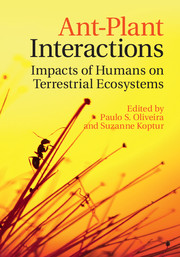Book contents
- Ant-Plant Interactions
- Ant-Plant Interactions
- Copyright page
- Contents
- Contributors
- Preface
- Part I Landscape Mosaics, Habitat Fragmentation, and Edge Effects
- Part II Ant-Seed Interactions and Man-Induced Disturbance
- Part III Ant-Plant Protection Systems under Variable Habitat Conditions
- 8 Plasticity and Efficacy of Defense Strategies against Herbivory in Ant-Visited Plants Growing in Variable Abiotic Conditions
- 9 Interhabitat Variation in the Ecology of Extrafloral Nectar Production and Associated Ant Assemblages in Mexican Landscapes
- 10 Integrating Ecological Complexity into Our Understanding of Ant-Plant Mutualism: Ant-Acacia Interactions in African Savannas
- 11 Ecological and Evolutionary Responses of Protective Ant-Plant Mutualisms to Environmental Changes
- Part IV Effect of Invasive Ants on Plants and Their Mutualists
- Part V Applied Ant Ecology: Agroecosystems, Ecosystem Engineering, and Restoration
- Part VI Perspectives
- Index
- Plate section
- References
10 - Integrating Ecological Complexity into Our Understanding of Ant-Plant Mutualism: Ant-Acacia Interactions in African Savannas
from Part III - Ant-Plant Protection Systems under Variable Habitat Conditions
Published online by Cambridge University Press: 01 September 2017
- Ant-Plant Interactions
- Ant-Plant Interactions
- Copyright page
- Contents
- Contributors
- Preface
- Part I Landscape Mosaics, Habitat Fragmentation, and Edge Effects
- Part II Ant-Seed Interactions and Man-Induced Disturbance
- Part III Ant-Plant Protection Systems under Variable Habitat Conditions
- 8 Plasticity and Efficacy of Defense Strategies against Herbivory in Ant-Visited Plants Growing in Variable Abiotic Conditions
- 9 Interhabitat Variation in the Ecology of Extrafloral Nectar Production and Associated Ant Assemblages in Mexican Landscapes
- 10 Integrating Ecological Complexity into Our Understanding of Ant-Plant Mutualism: Ant-Acacia Interactions in African Savannas
- 11 Ecological and Evolutionary Responses of Protective Ant-Plant Mutualisms to Environmental Changes
- Part IV Effect of Invasive Ants on Plants and Their Mutualists
- Part V Applied Ant Ecology: Agroecosystems, Ecosystem Engineering, and Restoration
- Part VI Perspectives
- Index
- Plate section
- References
- Type
- Chapter
- Information
- Ant-Plant InteractionsImpacts of Humans on Terrestrial Ecosystems, pp. 200 - 222Publisher: Cambridge University PressPrint publication year: 2017
References
- 2
- Cited by

